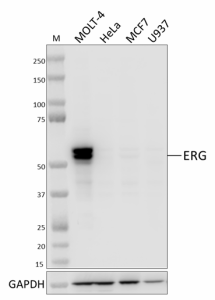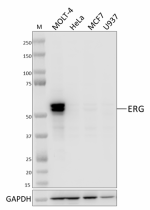- Clone
- W19256A (See other available formats)
- Regulatory Status
- RUO
- Other Names
- ETS-Related Gene, Transcriptional Regulator ERG, ETS Transcription Factor ERG, Erythroblast Transformation-Specific Transcription Factor ERG Variant 10, p55
- Isotype
- Rat IgG2a, κ
- Ave. Rating
- Submit a Review
- Product Citations
- publications

-

Whole cell extracts (15 µg total protein) from MOLT-4 (high expressor) , HeLa (low expressor), and MCF7 (low expressor) and U937 (negative control) lysates were resolved by 4-12% Bis-Tris gel electrophoresis, transferred to a PVDF membrane, and probed with 1.0 μg/mL (1:500 dilution) purified anti-ERG antibody (clone W19256A) overnight at 4°C. Proteins were visualized by chemiluminescence detection using HRP goat anti-rat IgG antibody (Cat. No. 405405) at a 1:3000 dilution. Direct-Blot™ HRP anti-GAPDH antibody (Cat. No. 607904) was used as a loading control at a 1:25000 dilution (lower). Lane M: Molecular weight marker. -

Whole cell extracts (250 µg total protein) prepared from MOLT-4 cells were immunoprecipitated overnight with 2.0 µg of purified rat IgG2a, k isotype ctrl antibody (Cat. No. 400501) or purified anti-ERG antibody (clone W19256A). The resulting IP fractions and whole cell extract input (6%) were resolved by 4-12% Bis-Tris gel electrophoresis, transferred to a PVDF membrane and probed with a control antibody against a separate epitope of ERG. Lane M: Molecular weight marker. -

HeLa cells (negative control) (panel A) and MOLT-4 cells (positive control) (panel B) were fixed with 4% paraformaldehyde for 10 minutes, permeabilized with Triton X-100 for 10 minutes, and blocked with 5% FBS for 60 minutes. Cells were then intracellularly stained with purified anti-ERG antibody (clone W19256A) overnight at 4°C followed by incubation with Alexa Fluor® 594 goat anti-rat IgG antibody (Cat. No. 405422) at 2.0 µg/mL. Nuclei were counterstained with DAPI and the image was captured with a 60X objective. -

MOLT4 cells (filled histogram, positive control) or U937 cells (open histogram, negative control) were fixed and permeabilized using the True-Nuclear™ Transcription Factor Buffer set (Cat. No. 424401), and intracellularly stained with ERG (clone W19256A) followed by PE goat anti-rat IgG antibody (Cat. No. 405406).
| Cat # | Size | Price | Quantity Check Availability | Save | ||
|---|---|---|---|---|---|---|
| 940201 | 25 µg | £81 | ||||
| 940202 | 100 µg | £201 | ||||
ERG (ETS-related gene) is a member of the erythroblast transformation-specific (ETS) family of transcription factors. Expressed in the mesoderm and endothelium of embryos, ERG is vital to embryonic cell differentiation as well as regulation of endothelial homeostasis, a role it sustains beyond the embryonic stage. Through transcriptional regulation of VE-cadherin, ICAM-2, and Claudin-5, ERG maintains endothelial junctional integrity and stability and regulation of the endothelial cytoskeleton through its interactions with HDAC6 and RhoJ. ERG is vital to angiogenesis, bone development, platelet adhesion, urogenital tract development, vascular stability, and proper hematopoiesis regulation. It plays a large role in cellular response to vascular inflammation, endothelial cell barrier function, and inhibition of vascular inflammation. These functions are accomplished largely through ERG-mediation of the Wnt/β-catenin signaling pathway by means of transcriptional regulation of FZD4 and VE-cadherin by ERG and subsequent promotion of β-catenin stability. This in turn promotes endothelial cell proliferation. ERG fusion proteins resulting from chromosomal translocations cause ERG to behave as a proto-oncogene, contributing to prostate cancer, megakaryoblastic leukemia, and Ewing’s sarcoma.
Product DetailsProduct Details
- Verified Reactivity
- Human
- Antibody Type
- Monoclonal
- Host Species
- Rat
- Immunogen
- Partial recombinant human ERG protein
- Formulation
- Phosphate-buffered solution, pH 7.2, containing 0.09% sodium azide
- Preparation
- The antibody was purified by affinity chromatography.
- Concentration
- 0.5 mg/mL
- Storage & Handling
- The antibody solution should be stored undiluted between 2°C and 8°C.
- Application
-
WB - Quality tested
ICC, IP, ICFC - Verified - Recommended Usage
-
Each lot of this antibody is quality control tested by western blotting. For western blotting, the suggested use of this reagent is 0.125 - 1.0 µg/mL. For immunocytochemistry, a concentration range of 1.0 - 5.0 μg/mL is recommended. For immunoprecipitation, the suggested use of this reagent is 2.0 µg/test. For immunocytochemistry, a concentration range of 1.0 - 5.0 μg/mL is recommended. For intracellular flow cytometry using our True-Nuclear™ Transcription Factor Staining Protocol, the suggested use of this reagent is ≤ 0.25 µg per million cells in 100 µL volume. It is recommended that the reagent be titrated for optimal performance for each application.
- Application Notes
-
This clone was tested for ICC using HeLa (low expressorl) and MOLT-4 (high expressor) cells fixed with 4% paraformaldehyde and permeabilized with either methanol or Triton X-100. Both methods resulted in robust ERG staining.
This clone does not recognize mouse ER.
When using this clone for ICFC, we recommend using the True-Nuclear™ Transcription Factor Buffer Set or the True Phos perm buffer. We do not recommend using the Intracellular Staining Permeabilization Wash Buffer for ICFC testing due to poor ERG staining.
True-Nuclear™ Transcription Factor Buffer Set gave a better signal to noise ratio at all tested concentrations when compared to the True Phos perm buffer. - RRID
-
AB_2892503 (BioLegend Cat. No. 940201)
AB_2892503 (BioLegend Cat. No. 940202)
Antigen Details
- Structure
- ERG is a 449 amino acid protein with an expected molecular weight of 54 kD.
- Distribution
-
Ubiquitously expressed/ Nucleus
- Function
- Transcription factor
- Cell Type
- Endothelial cells
- Biology Area
- Cell Biology, Ubiquitin/Protein Degradation
- Antigen References
-
1. Adamo P, et al. 2016. J. Biol. Chem. 35:4013
2. Birdsey G, et al. 2015. Dev. Cell. 32:82
3. Shah A, et al. 2016. Vascul. Pharmacol. 86:3 - Gene ID
- 2078 View all products for this Gene ID
- UniProt
- View information about ERG on UniProt.org
Related FAQs
Other Formats
View All ERG Reagents Request Custom Conjugation| Description | Clone | Applications |
|---|---|---|
| Purified anti-ERG Antibody | W19256A | WB,IP,ICC,ICFC |
Compare Data Across All Formats
This data display is provided for general comparisons between formats.
Your actual data may vary due to variations in samples, target cells, instruments and their settings, staining conditions, and other factors.
If you need assistance with selecting the best format contact our expert technical support team.
 Login / Register
Login / Register 











Follow Us